This is the fourth post in my series from last week’s camping trip to the Wichita Mountains National Wildlife Refuge in Oklahoma. The first post featured Post Oak Lake and Treasure Lake. The second was about a Coyote in Post Oak Creek. The third focused on White-tailed Deer at Post Oak Creek. For this post, I’m sharing my encounters with River Otters at Post Oak Creek.
River Otters are some of the most entertaining animals you can photograph in the wild. During my time at Post Oak Creek, I watched several otters go about their daily routines: grooming, hunting, and exploring their territory. Each encounter offered something different, and the bridge proved to be an ideal vantage point for observing their behavior up close.
Otter Rolling in the Sand
One otter climbed out of the water onto a sandy bank and immediately started rolling. This wasn’t just playful behavior; it was practical. River Otters have incredibly dense fur, with up to a million hairs per square inch, which traps air to keep them warm and buoyant in cold water. After swimming, they roll in sand or grass to help dry their coat and maintain that insulating layer. Watching this otter twist and rub against the ground was a reminder of how much energy these animals put into keeping their fur in top condition.
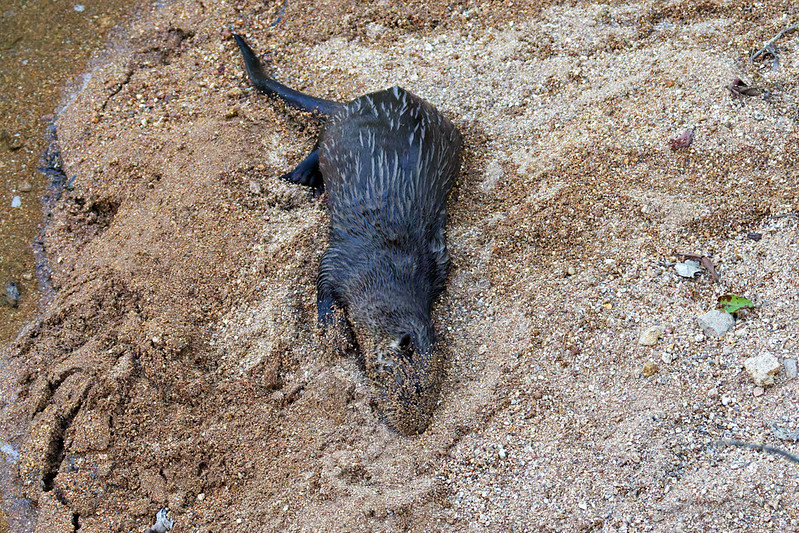
Otters Hunting Under Rocks
Another otter worked methodically along the creek bed, diving under rocks and probing the substrate with its sensitive whiskers. River Otters are opportunistic feeders, and their diet includes fish, crayfish, frogs, and aquatic insects. After several dives, this one surfaced with a fish clamped in its jaws. It didn’t swim to shore; it ate right there in the water, tearing into the fish while treading in place. The whole process took less than a minute before it dove back under to continue hunting.
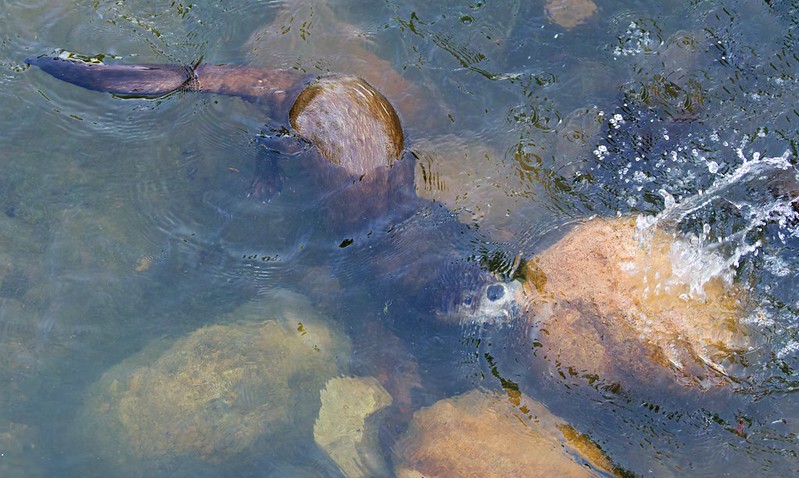
A Group of Three
Later, a group of three otters appeared together near the creek’s edge. Two stayed in the shallows, occasionally dipping their heads underwater, while the third swam in lazy circles nearby. River Otters are highly social animals, often traveling in family groups. These three seemed comfortable in each other’s presence, moving together without much fuss. It’s common to see otters in groups during the non-breeding season, especially mothers with older juveniles or adult siblings that haven’t dispersed yet.
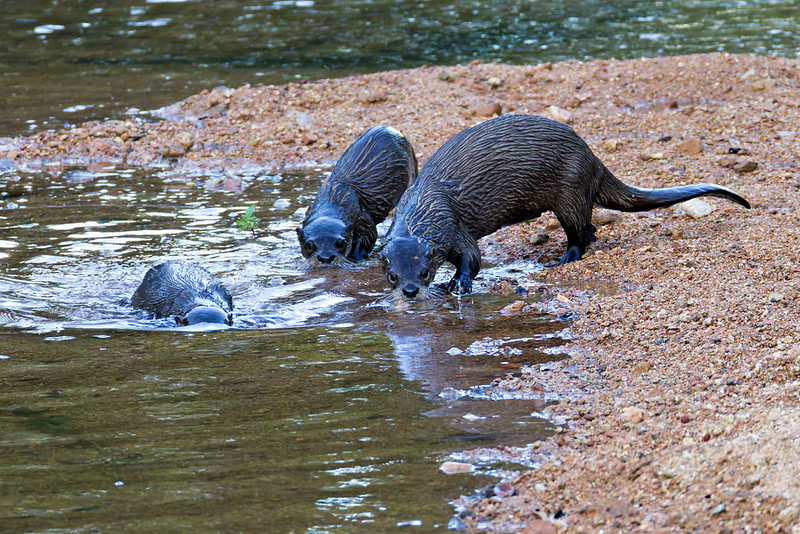
Eye Contact from Below
The most memorable moment came when a curious otter swam directly below the bridge I was standing on. I’d been watching it move upstream when it suddenly dove and disappeared. A few seconds later, it surfaced right beneath me, lifted its head out of the water, and locked eyes with me.
That direct eye contact lasted several seconds. Long enough for me to realize it was actively assessing whether I was a threat. River Otters are naturally curious, but they’re also cautious. After deciding I wasn’t a problem, it slipped back underwater and continued upstream.
That moment was unforgettable. There’s something powerful about being acknowledged by a wild animal on its own terms, especially one as intelligent and aware as a River Otter.
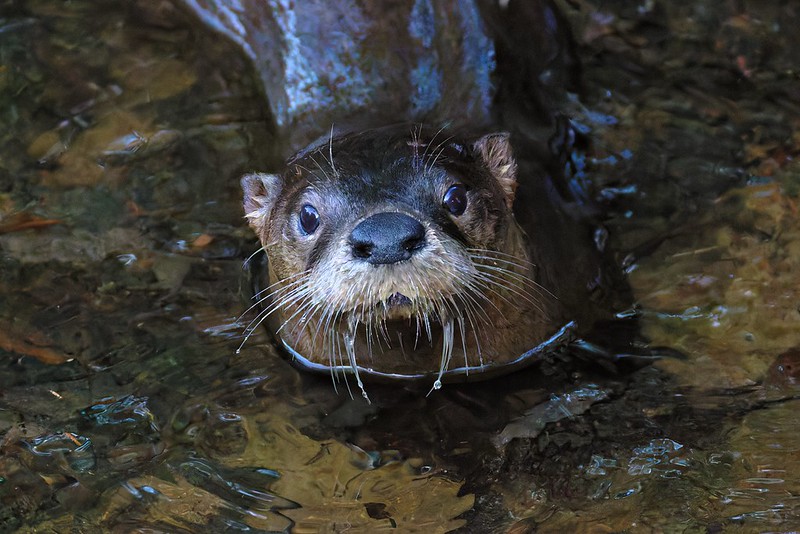
Wildlife Notes
River Otter (Lontra canadensis)
River Otters are semi-aquatic mammals found throughout much of North America, including Oklahoma. They’re members of the weasel family (Mustelidae) and are built for life in and around water. Their streamlined bodies, webbed feet, and powerful tails make them exceptional swimmers. They can hold their breath for up to eight minutes and dive to depths of 60 feet when hunting.
In Oklahoma, River Otters were once widespread but were extirpated by the mid-20th century due to unregulated trapping and habitat loss. Reintroduction efforts began in the 1980s, and populations have since recovered in many areas, including the Wichita Mountains. Post Oak Creek provides ideal habitat: clear water, plenty of cover, and abundant prey.
River Otters are most active at dawn and dusk, but they can be seen throughout the day in protected areas where human disturbance is low. They mark their territory with scent from glands near the base of their tail and often create latrines, designated spots where they deposit scat to communicate with other otters.
Their diet varies by season and availability but typically includes fish, crayfish, amphibians, and occasionally small mammals or birds. They’re opportunistic hunters and will take whatever prey is easiest to catch. In Post Oak Creek, the rocky substrate and clear water make crayfish and small fish particularly abundant.
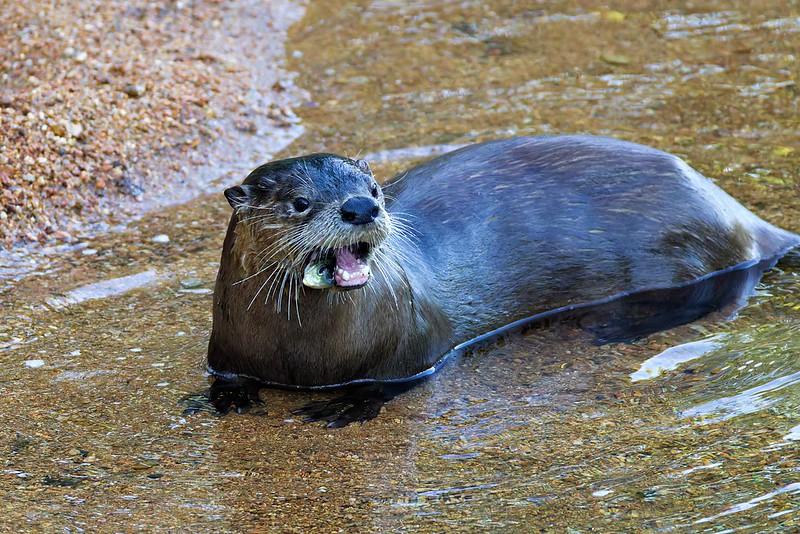
Photography Notes
I was able to park my truck a distance from the bridge and walk back to photograph these otters while standing on the bridge. This approach minimized disturbance and gave me a stable, elevated position for observing their behavior.
The light was low and uneven, typical for shaded creeks in late afternoon, but the Canon R5 Mark II handled the challenging conditions well. The RF 200-800mm lens gave me the reach I needed without disturbing the otters, and the image stabilization helped compensate for the slower shutter speeds required in dim light.
I shot at ƒ/9 to maintain enough depth of field for the otters’ bodies, even when they were partially submerged or moving quickly. Shutter speed stayed at 1/640 second to freeze motion, fast enough to stop a swimming otter or a head shake without introducing blur. ISO ranged from 6400 to 12,800 depending on how much light was available at any given moment. The R5 Mark II’s sensor performs remarkably well at high ISO, keeping noise manageable even in the shadows.
The biggest challenge was tracking the otters as they moved. They’re unpredictable, surfacing, diving, and changing direction without warning. I kept the camera in continuous autofocus mode and used the animal eye detection feature, which locked onto the otters’ faces whenever they surfaced. That made a huge difference in keeping sharp focus during fast sequences.
Camera Settings:
- Camera: Canon EOS R5 Mark II
- Lens: Canon RF 200-800mm F6.3-9 IS USM
- Aperture: ƒ/9
- Shutter Speed: 1/640 second
- ISO: 6400 to 12,800
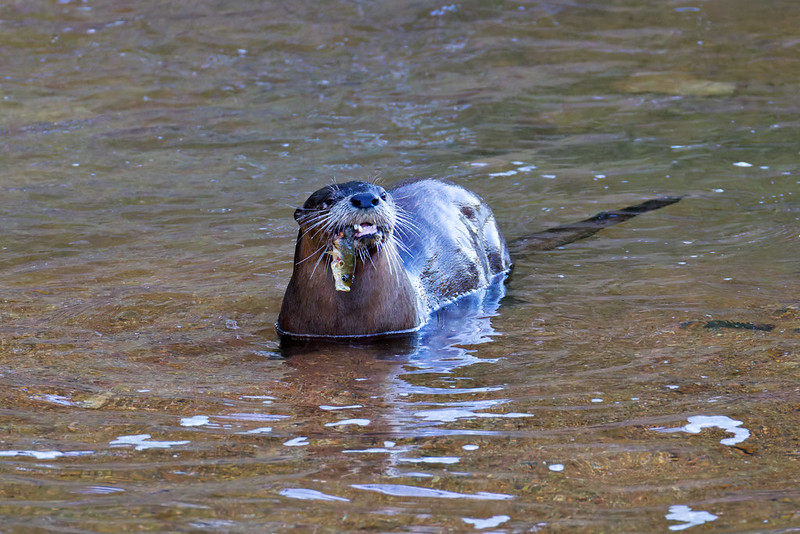
Post Oak Creek turned out to be a perfect spot to observe River Otter behavior up close. Whether they’re feeding, socializing, or simply checking out their surroundings, these animals are always entertaining to watch. If you’re planning a trip to the Wichita Mountains, keep an eye on the creeks; you never know when an otter might surface right in front of you.

Oh my gosh, they all look nice and healthy. I really like the photos of them eating. Now I wonder what their lifespan is. I will Google that!